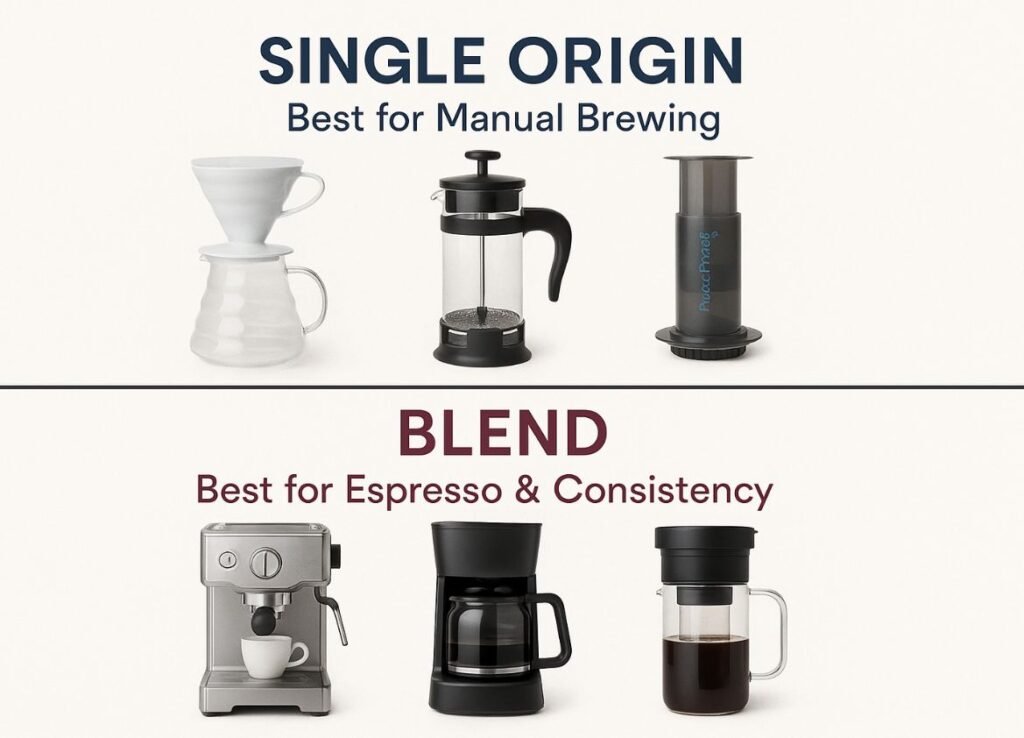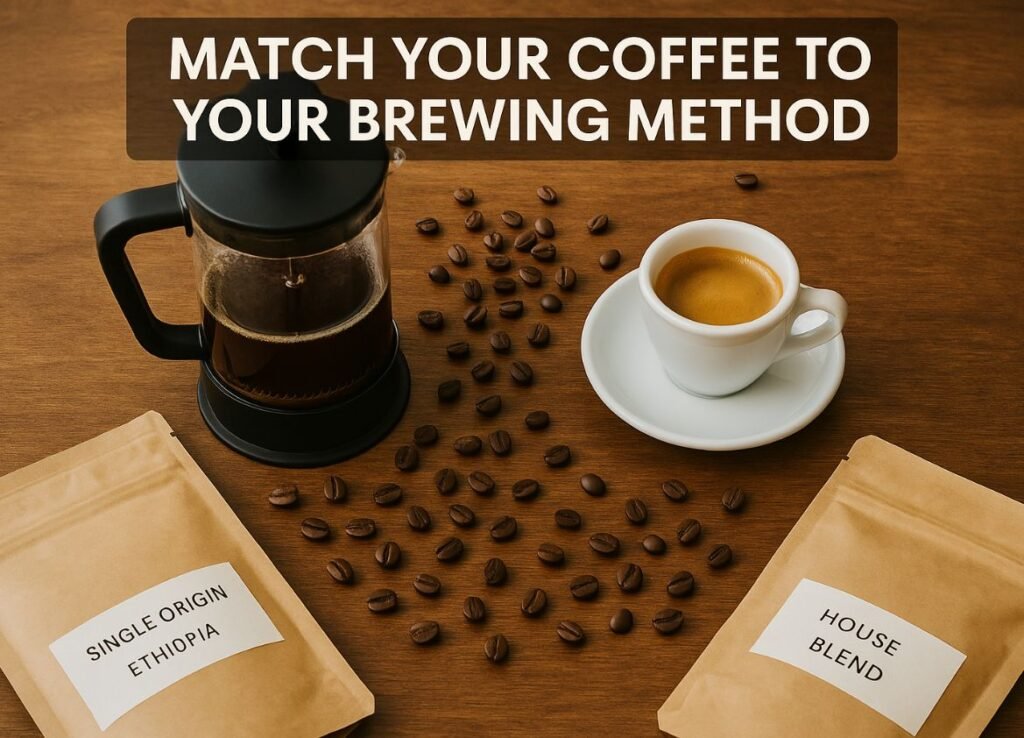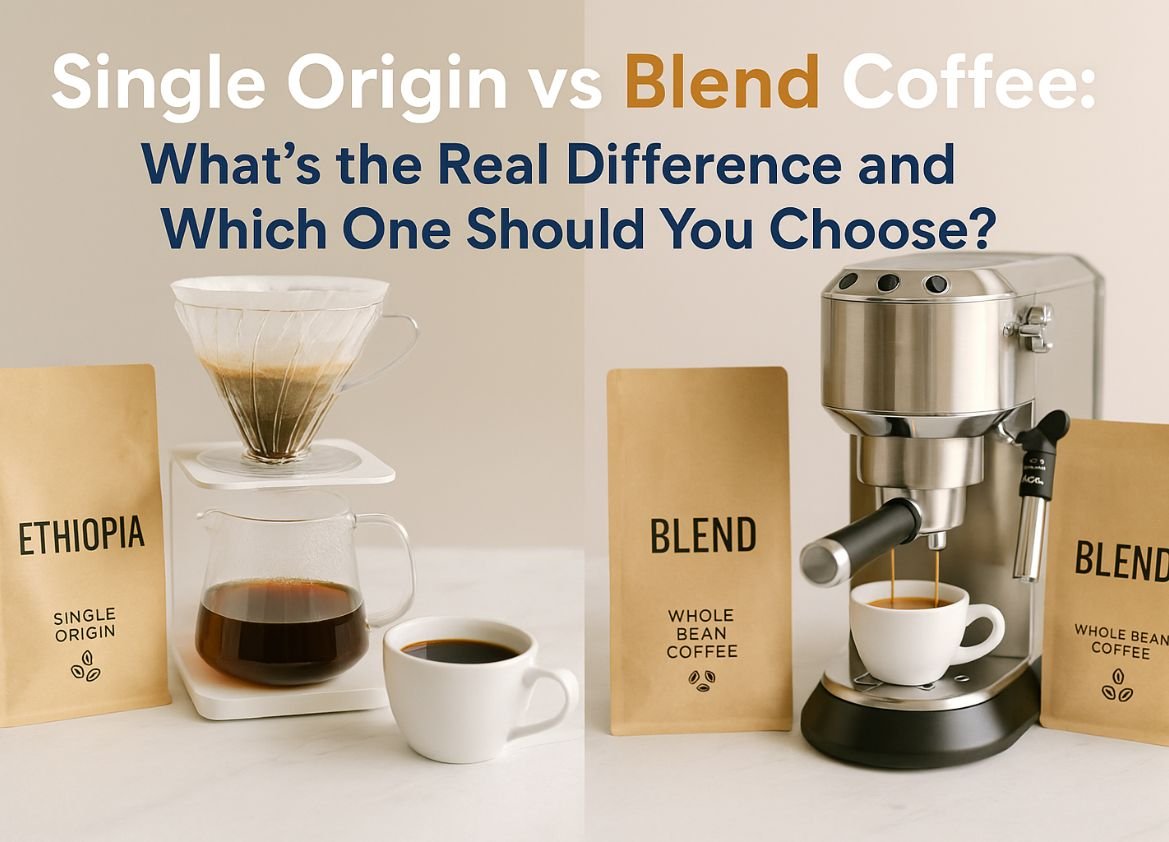Walk into any specialty coffee shop and you’ll face a tough decision single origin or blend?
Here’s the thing most people overthink this choice. They assume single origin is automatically better because it sounds fancier or they grab a blend thinking it’s just “regular coffee.
Both assumptions wrong.
I’ve spent years testing coffee from Ethiopia to Guatemala, from small-batch roasters to commercial brands. And I can tell you this: the best coffee isn’t about single origin vs blend coffee it’s about matching the right type to your taste, brewing method, and budget.
Want to stop wasting money on coffee that disappoints? Want to actually understand what you’re buying? In the sections ahead, I’ll walk you through what makes single origin and blends unique, explain how to assess your preferences, and give you practical tips for choosing the right beans for your taste, method, and budget.
No fluff. No coffee snob jargon. Just straight facts that’ll transform how you buy beans.
Key Takeaways
- Single origin coffee comes from one region and offers unique, distinct flavors that change seasonally perfect for adventurous coffee lovers who want traceability and specialty brewing methods.
- Blend coffee combines beans from multiple regions for balanced, consistent flavor year-round ideal for espresso and everyday drinking without breaking the bank.
- Your brewing method matters single origin shines in pour over and French press, while blends dominate in espresso machines and drip coffee.
- Price isn’t everything single origin typically costs more but offers transparency; blends deliver value and reliability.
- Try both Your perfect coffee depends on personal taste preference, not what coffee snobs tell you is “better”
What Is Single Origin Coffee?
Single origin coffee means exactly what it sounds like: beans sourced from one specific geographic location.
That location could be a single farm, a cooperative of farms in one region, or even a specific lot within a farm. The key? All the beans share the same origin story.
Here’s why this matters: coffee tastes different based on where it grows. The soil, altitude, climate, and processing methods all create unique flavor profiles. When you buy single origin beans, you’re tasting the pure expression of that place.
Characteristics That Set Single Origin Apart
Flavor Consistency (Within Season): Single origin coffee delivers a distinct taste profile. Ethiopian Yirgacheffe? Expect bright, fruity notes with floral hints. Colombian beans? Think balanced sweetness with nutty undertones.
Traceability: You know exactly where your coffee comes from. Many specialty roasters provide detailed information about the farm, elevation, and processing method. This transparency matters if you care about ethical sourcing.
Seasonal Availability: Here’s the catch—single origin beans aren’t always available. Coffee is an agricultural product with harvest seasons. That amazing Guatemalan coffee you loved in spring? It might be sold out by fall.
Popular Single Origin Regions
- Ethiopia: The birthplace of coffee. Expect complex, fruity flavors with wine-like acidity
- Colombia: Balanced, approachable beans with caramel sweetness and mild acidity
- Guatemala: Rich, chocolatey notes with a full body
- Kenya: Bold, bright acidity with berry and citrus flavors
- Costa Rica: Clean, crisp taste with honey-like sweetness
Single origin beans are the darling of specialty coffee culture. They’re what you’ll find at third-wave coffee shops where baristas treat brewing like a science experiment.
But are they actually better? Hold that thought.
What Is Blend Coffee?
Blend coffee is a mix of beans from multiple regions, farms, or even countries—carefully combined by roasters to create a specific flavor profile.
Think of it like a chef creating a signature dish. Instead of showcasing one ingredient, they’re balancing multiple components to achieve something greater than the sum of its parts.
Why Roasters Create Blends
Balanced Flavor: Blending allows roasters to combine the best characteristics of different beans. Maybe they want the body of Brazilian beans with the brightness of Kenyan coffee and the sweetness of Colombian beans. Boom—they blend them.
Year-Round Consistency: Unlike single origin coffee that changes with harvest seasons, blends can maintain the same taste profile throughout the year. When one bean runs out, roasters substitute with a similar variety to keep the flavor consistent.
Cost Efficiency: Let’s be real blends are often more affordable. Roasters can use less expensive beans in the mix while still delivering great taste. That doesn’t mean lower quality; it means smarter sourcing.
Common Types of Coffee Blends
Espresso Blend– Specifically designed to shine under high pressure. Usually darker roasted with a balanced flavor that cuts through milk in lattes and cappuccinos.
Breakfast Blend– Lighter, approachable coffee meant for drip brewing. Smooth, mild, and easy drinking for your morning routine.
House Blend-A roaster’s signature mix. This is their “greatest hits” compilation the flavor they want to be known for.
Dark Roast Blend– Bold, intense, and full-bodied. Often used for French roast or Italian roast profiles.
Here’s what most people miss: creating a great blend requires serious skill. Master roasters spend years perfecting ratios and roast levels to achieve consistent, delicious results.
Blends aren’t “lesser” coffee. They’re engineered coffee designed with purpose and precision.
Single Origin vs Blend Coffee – What To Look For Before You Buy

Alright, let’s cut to the chase. When you’re standing in front of those coffee bags (or scrolling through an online store), here’s exactly what you need to compare:
Quick Comparison- Single Origin vs Blend Coffee
| Factor | Single Origin | Blend |
|---|---|---|
| Flavor Profile | Distinct, unique to region; can be adventurous | Balanced, consistent; crowd-pleasing |
| Taste Consistency | Varies by season and harvest | Same taste year-round |
| Price Range | $16-$25+ per 12 oz | $10-$18 per 12 oz |
| Availability | Seasonal; limited batches | Always available |
| Traceability | High; specific farm or region | Lower; multiple sources |
| Best Brewing Methods | Pour-over, French press, AeroPress | Espresso, drip coffee, cold brew |
| Complexity | High; showcases unique characteristics | Moderate; engineered for balance |
| Risk Factor | Higher; you might not like the unique flavor | Lower; designed to appeal broadly |
Breaking Down What Matters Most
Flavor Profile: Do you want to taste coffee that screams “I’m from Ethiopia!” with wild blueberry notes? Go single origin. Want something smooth and reliable that tastes great every morning? Blend wins.
Consistency: Single origin coffee changes. Same farm, different harvest, different taste. If you find a blend you love, it’ll taste the same when you reorder next month.
Price: You’ll pay a premium for single origin beans—and that’s okay if you value the unique experience and transparency. Blends deliver excellent value without sacrificing quality.
Purpose: Here’s the real game-changer—your brewing method should influence your choice. Espresso machines? Blends are engineered for that. Manual brewing where you can control every variable? Single origin shines.
The Question Nobody Asks (But Should)
“Will I actually taste the difference?”
Honest answer: If you’re drinking coffee with cream and sugar, you probably won’t notice the subtle nuances of single origin. The unique flavor characteristics get masked.
But if you drink coffee black or with just a splash of milk? You’ll absolutely taste the difference between a fruity Ethiopian single origin and a balanced breakfast blend.
Bottom line: Don’t buy single origin to impress your friends. Buy it because you genuinely want to explore different flavor profiles.
Pros and Cons of Single Origin Coffee
Let’s get real about single origin. It’s not all sunshine and perfectly extracted pour-overs.
Advantages of Single Origin Coffee
Unique Flavor Experience: Every bag tells a story. You’re not just drinking coffee—you’re tasting the terroir of a specific place. That’s genuinely cool if you’re into exploring flavors.
Complete Transparency: You know exactly where your money goes. Many single origin coffees come with details about the farm, the farmers, and the processing method. If ethical sourcing matters to you, this transparency is invaluable.
Quality Focus: Single origin beans are typically higher grade. Roasters don’t hide behind blending—the beans have to stand on their own merit.
Perfect for Manual Brewing: If you’re into pour-over, French press, or AeroPress, single origin coffee lets you geek out on extraction and really taste what you’re brewing.
Conversation Starter: Okay, this sounds pretentious, but there’s something fun about sharing coffee from a specific Ethiopian farm with friends. It creates an experience.
Drawbacks of Single Origin Coffee
Inconsistent Availability: Fall in love with a Guatemalan coffee? Good luck finding it six months later. Seasonal harvests mean your favorite might disappear.
Higher Price Point: You’re paying for traceability, quality, and often smaller batch roasting. Expect to spend $18-$30 per bag.
Flavor Risk: Sometimes that “unique flavor profile” translates to “weird taste I don’t like.” Not every single origin will match your palate.
Less Forgiving in Brewing: Single origin beans can be finicky. Slight changes in water temperature or grind size can dramatically affect taste. Blends are more forgiving.
Overwhelming Choices: With hundreds of regions and farms, choosing single origin coffee can feel paralyzing for beginners.
Real-World Example
Counter Culture Coffee’s Ethiopia Sidama: This is a classic single origin that showcases everything great about the category. Bright, fruity, with notes of blueberry and lemon. It’s transparent (they list the farm cooperative), delicious when brewed carefully, and… $19 for a 12 oz bag. When it’s gone, it’s gone until next harvest.
Perfect for coffee enthusiasts. Frustrating for someone who just wants consistent morning coffee.
Pros and Cons of Blend Coffee
Blends don’t get enough credit. Let me fix that.
Advantages of Blend Coffee
Balanced, Approachable Flavor: Roasters engineer blends to taste good to most people. You’re getting the best characteristics of multiple beans working together.
Year-Round Consistency: Find a blend you love? It’ll taste the same when you reorder. Roasters maintain the flavor profile even when sourcing changes.
Better Value: Blends typically cost less while still delivering excellent quality. You’re not paying a premium for single-farm traceability.
Forgiving Brewing: Mess up your water temperature? Grind slightly too coarse? Blends are more forgiving and still taste good.
Designed for Specific Uses: Espresso blends are optimized for espresso machines. Breakfast blends work perfectly in drip coffee makers. You’re getting coffee designed for your brewing method.
Always Available: No seasonal limitations. Your favorite blend will be in stock whenever you need it.
Drawbacks of Blend Coffee
Less Traceability: You usually don’t know the specific farms or regions. If transparency matters to you, this is a dealbreaker.
Can Mask Lower Quality: Some commercial blends use mixing to hide inferior beans. Not all blends, but it happens.
Less Adventurous: If you love exploring unique flavors, blends might feel boring. They’re designed for consistency, not excitement.
Harder to Geek Out: Coffee nerds want to discuss terroir and processing methods. Blends don’t offer that same depth of conversation.
Real-World Example
Stumptown Hair Bender: This is what a great blend looks like. It combines beans from Latin America, Indonesia, and Africa to create a complex but balanced flavor—sweet, fruity, with chocolate notes. It costs about $14 per bag, tastes the same every time, and works beautifully as espresso or drip coffee.
It’s reliable, delicious, and affordable. But you won’t know which specific Colombian farm contributed beans.
Single Origin vs Blend Coffee – Which Is Better for You?

Stop looking for the “better” option. Start looking for the right option for your situation.
Here’s how to actually decide:
Choose Single Origin If…
- You drink coffee black and want to taste complex flavors
- You use manual brewing methods like pour-over, French press, or AeroPress
- Transparency matters you and you want to know exactly where your coffee comes from
- You enjoy variety and like trying different flavors regularly
- Budget isn’t your primary concern and you’re willing to pay for quality and traceability
- You’re a coffee enthusiast who wants to explore the world through coffee
Choose Blend If…
- You make espresso or use a drip coffee maker
- You add milk or cream to your coffee
- You want consistency the same great taste every morning
- Value matters and you want excellent coffee at a reasonable price
- You’re new to specialty coffee and want something approachable
- You drink a lot of coffee and need reliable, always-available beans
The Real Answer? Try Both
Here’s what I actually recommend: Don’t commit to one camp.
Buy a bag of single origin for weekend brewing when you have time to appreciate it. Keep a blend for weekday mornings when you just need reliable fuel.
Use single origin for your Saturday pour-over ritual. Use blend for your Monday espresso that gets you out the door.
This isn’t cheating. It’s smart. Different situations call for different coffee.
Pairing Coffee Types With Brewing Methods
The brewing method matters more than most people realize. Here’s the breakdown:
Single Origin Shines In:
- Pour-Over (V60, Chemex): Clean brewing that highlights unique flavors
- French Press: Full immersion brings out body and complexity
- AeroPress: Versatile method that can emphasize different characteristics
- Siphon: Theatrical brewing that showcases clarity and brightness
Blend Dominates In:
- Espresso Machine: High pressure needs balanced beans that won’t turn sour or bitter
- Drip Coffee Maker: Automated brewing works better with forgiving, consistent blends
- Cold Brew: Long extraction time benefits from balanced flavor profiles
- Moka Pot: Intense brewing method needs robust, well-rounded beans
I’ve tested this extensively. A bright Ethiopian single origin in espresso? Often too acidic and sour. That same coffee in a pour-over? Absolutely stunning.
Meanwhile, a well-crafted espresso blend in a French press? Perfectly enjoyable. In an espresso machine? Exceptional.
Match your coffee type to your brewing method, and you’ll instantly improve your results.
Where To Buy High-Quality Single Origin and Blend Coffee
You’ve decided what you want. Now where do you actually buy it?
Local Specialty Roasters (Best Option)
This is my top recommendation. Local roasters typically:
- Roast in small batches for maximum freshness
- Provide detailed information about their beans
- Let you ask questions and get recommendations
- Support your local economy
- Often let you sample before buying
Pro tip: Ask when they roasted the beans. Coffee tastes best 4-14 days after roasting. Anything sitting on the shelf for months Skip it.
Reputable Online Coffee Roasters
Can’t find great local options? These online roasters consistently deliver quality:
For Single Origin: Counter Culture, Onyx Coffee Lab, Heart Coffee, Sweet Maria’s
For Blends: Stumptown, Intelligentsia, Blue Bottle, Verve Coffee
For Both: Trade Coffee (subscription service that matches you with roasters)
What to look for when buying online:
- Roast date clearly listed (not just “best by” date)
- Information about origin, processing, and tasting notes
- Whole bean options (pre-ground coffee loses flavor fast)
- Reasonable shipping times (you want fresh beans, not stale ones that sat in a warehouse)
Subscription Services Worth Considering
Coffee subscriptions can be hit or miss, but some are genuinely excellent:
- Trade Coffee: Algorithm matches you with different roasters; great for exploration
- Atlas Coffee Club: Single origin coffees from different countries each month
- MistoBox: Customizable based on your taste preferences
Warning: Avoid generic grocery store “coffee clubs.” They usually send stale, commodity-grade coffee with fancy packaging.
What About Grocery Stores?
Real talk: Most grocery store coffee is weeks or months old. The exceptions:
- Stores with in-house roasting programs
- Specialty grocers like Whole Foods that partner with local roasters
- Bags with clearly printed roast dates (rare but they exist)
If you’re buying from a grocery store, check the roast date. No roast date listed? That’s a red flag.
Price Expectations
Single Origin: $16-$30 per 12 oz bag
Blend: $12-$20 per 12 oz bag
Subscription Services: $15-$25 per bag (including shipping)
Yes, specialty coffee costs more than Folgers. But you’re drinking 2-3 cups from 2 oz of beans. That “expensive” $20 bag makes about 24 cups—less than $1 per cup. Cheaper than any coffee shop.
Conclusion
The single origin vs blend coffee debate isn’t about which is objectively better. It’s about which is better for you, right now, for your specific brewing method and taste preferences.
Here’s what you need to remember:
Single origin coffee gives you unique, traceable flavors that change seasonally. It’s perfect for coffee enthusiasts who want to explore, prefer manual brewing methods, and value transparency. You’ll pay more, but you’re getting a distinct experience.
Blend coffee delivers balanced, consistent flavor year-round at a better price point. It’s ideal for espresso, everyday drinking, and anyone who wants reliable, delicious coffee without the complexity.
The smartest move Stop overthinking and start experimenting.
Buy one bag of single origin. Buy one bag of blend. Brew them side by side. Taste the difference. Then decide based on your actual experience not what coffee snobs on the internet tell you.
Your perfect coffee is the one you genuinely enjoy drinking. Period.
Ready to Discover Your Perfect Brew?
Here’s your action plan:
- Identify your primary brewing method (espresso, pour-over, drip, etc.)
- Choose one single origin and one blend that match that method
- Buy from a reputable roaster with clear roast dates
- Taste them side by side (black, if possible)
- Buy more of what you actually prefer not what you think you should prefer
Stop wasting money on coffee that disappoints. The difference between mediocre and exceptional coffee isn’t complicated it’s about matching the right beans to your brewing method and taste preferences.
Now go make yourself an incredible cup of coffee. You’ve got this.
